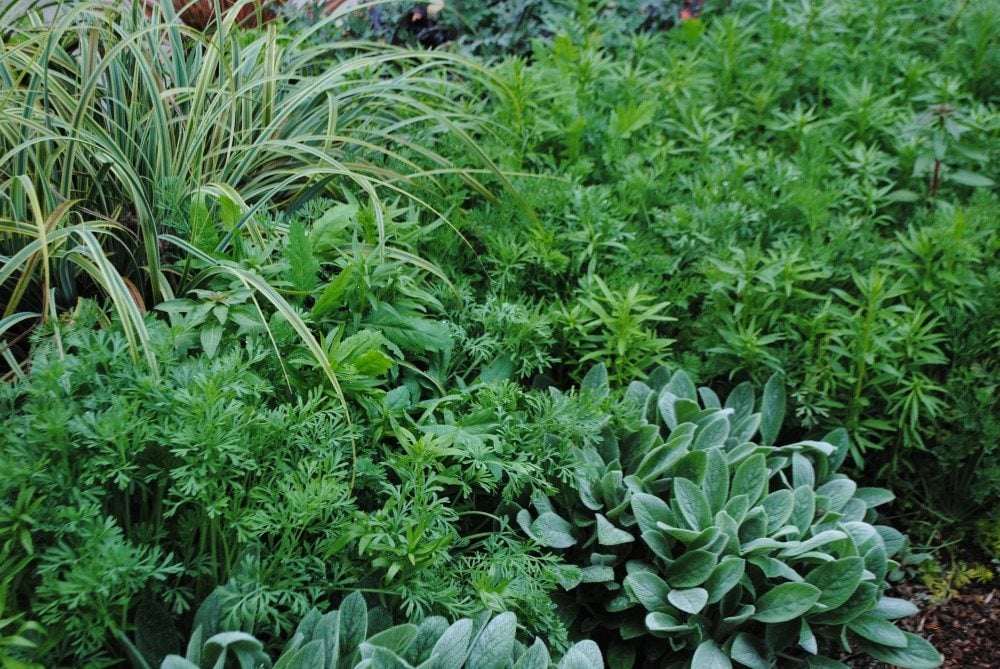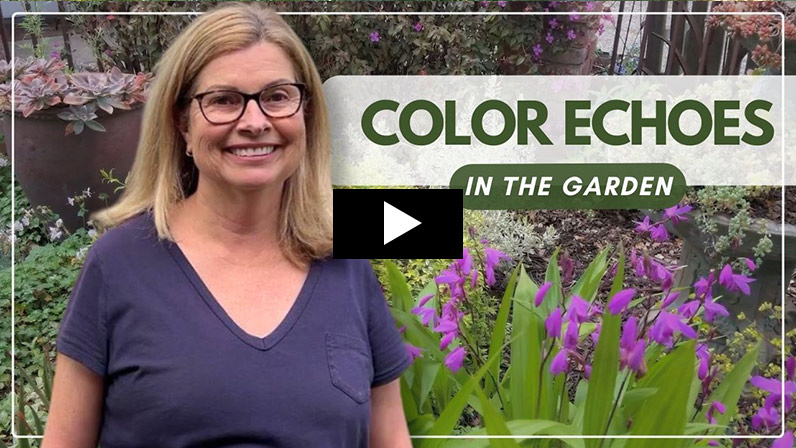Creating Echoes in the Garden
WHAT IS AN ECHO?
In garden design, an echo is the repetition of specific elements used throughout the garden. These elements may include colors, shapes, forms, textures, or even unique features such as arches, pathways, or decorative objects. Flowers and foliage are the most common sources of echoes and are often referred to as ‘simple echoes’.
Apart from their visual appeal, echoes serve specific functions in the garden. They create harmony and rhythm between garden beds, establish a natural flow by visually connecting different areas of the garden, and even help unify a disjointed garden bed, which can occur with too many random plant purchases.

The soft gold and yellow colors gently wind throughout this garden, creating a harmonious rhythm and flow. The Heather Garden, designed by Lynden B. Miller. Photo by: Rebecca Sweet.
STRATEGIES FOR CREATING SIMPLE ECHOES
Repetition with Color
Think of color echoes as a beautiful ribbon that weaves throughout the garden, tying everything together. At its core, a color echo is a combination of colors that contain elements of one another within each of them. It’s important to remember that a color echo incorporates hints of the same color rather than using exact matches. One of the easiest ways to create a color echo is by combining plants with flowers or foliage with hints of the same color within them.

The peachy buds of the Helichrysum ‘Amber Clusters’ are within the same color family as the neighboring deep garnet foliage of sterile ‘Golden Ruby’ barberry, resulting in a harmonious color echo. Photo by: Rebecca Sweet.
Repetition with Texture
When echoed throughout the garden, texture is one more way to weave another layer of unity (and harmony) throughout the space. While textural echoes may often be subtle, they’re nonetheless powerful. Some of the most harmonious gardens have many subtle layers that come together as a whole, resulting in an unforgettable experience.
To start incorporating texture echoes into your garden, closely examine a plant's foliage to identify and replicate its textural qualities using a different plant. Similar to creating color echoes, flowers and foliage are often the most common sources to provide interesting textures.

The rough and bumpy textures of the various succulents unite them while also echoing the texture of the bricks. Photo by: Rebecca Sweet.
Repetition with Shape & Form
While often used interchangeably, shape and form have separate (though similar) meanings. Shape refers to a plant’s two-dimensional qualities, also called its outline, silhouette, or contour. To determine the shape, look at a plant or leaf and imagine drawing a line around it. You’ll notice shapes like fountains, columns, round, heart-shaped, strap-like, etc.
Form, on the other hand, is three-dimensional and includes depth along with the outline or contour. Another way to think of form is the overall shape of a plant when in leaf (the leaves emphasizing the depth). To create a simple echo, choose a plant with an interesting shape or form, then repeat that shape using a different plant placed here and there throughout the garden.

The shape of the green heuchera leaves echoes the shape of the foliage and flowers of the ornamental Oxalis ‘Sunset Velvet’. An interesting color echo is also happening between the amber oxalis foliage and the container itself. Photo by: Rebecca Sweet.
COMPLEX ECHOES
Taking It up a Notch
After experimenting with creating simple echoes, you’re ready to take your garden to the next level through the use of ‘complex echoes’. These types of echoes focus on pulling together other, less obvious, garden elements for your echo combination. Elements such as a plant’s stems or berries, edibles, or even hardscaping are just a few examples that can help create a little visual magic in the garden.

A whimsical color echo is created when echoing the pink-tipped spines of a devil’s tongue cactus (Ferocactus latispinus) and planting it in a bubblegum-pink container. Design by Jeanne Meadow. Photo by: Rebecca Sweet.
Sources for Complex Color Echoes
The more you experiment with creating color echoes with foliage and flowers, the more you’ll begin to notice a plant’s other sources of color. While a flower’s petals may be the first (and most obvious) color to come to mind, look a little deeper, and you may notice other sources of colors, such as a petal’s subtle shading, stamens, or seed heads. In addition, look a little deeper at a plant to discover color coming from its stems or the underside of a leaf.

Instead of choosing the bright white color of the cosmos petals for a color echo, the small, yellow eye is highlighted and repeated with the golden button-like blooms of the Chrysocephalum 'Desert Flame.' Photo by: Rebecca Sweet.
Sources for Complex Texture Echoes
As you become more confident in creating textural echoes between foliage and flowers, look for other sources of texture to highlight, such as seedpods, old growth, edibles, stems, and bark. While many complex echoes are subtle, their influence on the garden’s overall harmony is strong. An added bonus of many unusual texture sources is their seasonality, essential for creating year-round interest.

The fuzzy buds of the Salix caprea 'Kilmarnock' are a perfect example of an unusual source of texture in the garden, just waiting to be echoed with other nearby foliage or flowers. Photo by: Rebecca Sweet.
Sources for Complex Shape & Form Echoes
Create complex form echoes by repeating a plant’s form or shape with different elements in the garden. For example, instead of echoing the vertical form of an Ilex crenata ‘Sky Pencil’ by planting several of the same plant repeatedly, highlight its vertical form by surrounding it with vertical flowers or an upright-growing grass.

The long, slender foliage of the Carex secta echoes the long, tubular flowers of the nearby cuphea ‘Firecracker’. Photo by: Rebecca Sweet.
Complex Echoes Using Non-Living Elements
While it’s tempting to focus on creating echoes using only plants, remember the non-living elements in your garden. Non-living elements such as hardscaping (patios, pathways, and fences), containers, artwork, fountains, and sculptures are so much more than pretty accessories in your garden—they’re often prime candidates for creating complex echoes. When all of the individual players in your garden have common, yet distinct, threads that connect them, the result is a cohesive and harmonious garden.

An eye-catching shape echo is created between the impressive birdhouse's triangular roofline and the delphiniums' upright flowers. Designed by Freeland and Sabrina Tanner. Photo by: Rebecca Sweet.
Seasonal Echoes
Creating seasonal echoes in your garden is another way to develop complex echoes that celebrate the essence of each season. For example, a spring complex echo might include vibrant bulbs echoing early-blooming ephemerals. On the other hand, summer provides a different season to create surprising color and texture echoes long after the spring bulbs have faded. Fall is ideal for highlighting the fiery colors of fall foliage and textural grasses. During winter, the garden’s other elements take their turn in the spotlight with texture and form at the heart of a winter bark show. Features such as textural tree bark, a grass’s tawny inflorescence, highly structural dried seedpods, and interesting evergreen forms keep the garden interesting until spring arrives once again.

The late winter fruit from a ‘Washington’ orange tree is echoed by early spring’s orange tulips. Photo by: Rebecca Sweet.
PREVENT MONOTONY
Add a Bit of Contrast
While it’s accurate to say that repetition throughout a garden’s different layers (ie: color, texture, form, or shape) creates a sense of unity and rhythm, too much repetition can quickly turn harmony into monotony. Imagine watching the same scene repeatedly in a play, and how tiresome that would be! This principle applies to gardening, as well.
When establishing an echo, introduce a contrasting element to prevent monotony. For instance, position a complementary color nearby or incorporate a plant with a significantly different texture or form. This creates juxtaposition and that visual ‘punch’ a garden may need to wake it up again.

The bridge’s red color provides the perfect contrast in this serene and green garden. It wouldn’t have nearly the impact if it were painted black or brown! Kubota Garden, Seattle. Photo by: Rebecca Sweet.
Color
Remember, a color echo uses subtle hints of the same color, not necessarily using only the same color. To prevent a lackluster combination when creating an echo, include shades of the color that range from lightest to darkest. Take it one step further and use a color wheel to help determine the color echo’s opposite (or complementary color), and place that color nearby to help grab the eye’s attention.

There’s nothing lackluster about this lush and green garden, thanks to the complementary red and orange colors of the flowers and container. Photo by: Rebecca Sweet.
Texture
Textural repetition is another element that can look dull and predictable when overdone throughout the garden. For example, placing too many fuzzy plants together will result in the impact of this unique texture being lost. However, by placing a contrasting texture nearby (such as bold or shiny), the effect of the fuzzy texture is heightened. This contrasting texture helps wake up the combination, adding a much-needed jolt of excitement.

Even though the colors are soothing, monochromatic shades of green, the variation in textures is interesting enough to hold one’s attention. Photo by: Rebecca Sweet.
Form and Shape
The importance of contrast when repeating form or shape is no different than color and texture—the occasional contrasting element helps create dynamic energy. For example, a garden with an excessive use of gentle mounding shapes and forms might lull one to sleep without an unexpected, contrasting form mixed in. To wake things up, insert a plant with a contrasting vertical form. The result remains harmonious, yet dynamic.

While the flowers in this meadow are all light and airy, their contrasting shapes prevent them from blending into one another. Photo by: Rebecca Sweet.
Color Echoes in the Garden

BOOK REBECCA AS YOUR NEXT GARDEN SPEAKER!
Fun, passionate, and knowledgeable, three words that describe Rebecca Sweet! See what discussion topics are available and watch a short video as Rebecca explains how her talks will inspire, entertain, and educate gardeners at all skill levels.
RELATED:
More from Rebecca Sweet
Elements & Principles of Landscape Design
Tanner Garden: Rooted in Imagination

